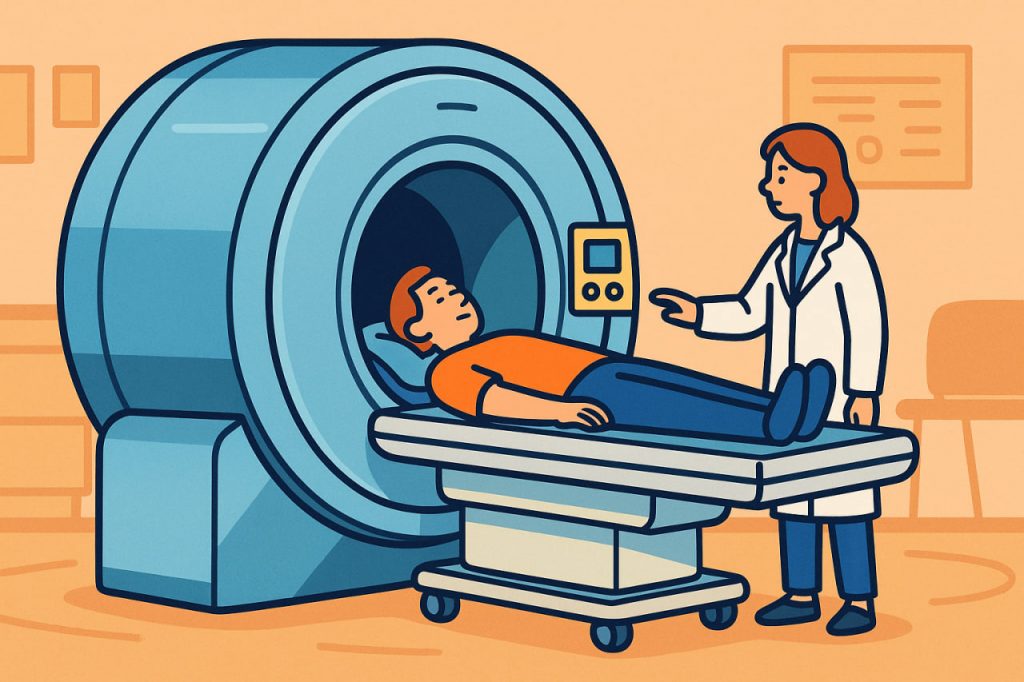An MRI machine (Magnetic Resonance Imaging machine) is a powerful medical device that creates detailed images of the inside of the human body using strong magnetic fields and radio waves. Unlike X-ray or CT machines, MRI does not use ionizing radiation, making it a safer option for many diagnostic purposes. It is especially effective for examining soft tissues such as the brain, muscles, and internal organs.
The Principle Behind MRI
MRI works on the principle of nuclear magnetic resonance. The human body is mostly made of water, and water molecules contain hydrogen atoms. When a person is placed inside the MRI machine, the powerful magnetic field causes the nuclei of hydrogen atoms to align in a certain direction.
The Role of Radio Waves
Once the hydrogen nuclei are aligned, the MRI machine sends a pulse of radio waves through the body. This temporarily knocks the nuclei out of alignment. As they return to their original state, they release energy. Sensors in the MRI machine detect this released energy and send the data to a computer.
Creating the Image
The computer processes the signals into detailed images. Because different tissues (muscles, fat, brain matter, etc.) release signals in slightly different ways, MRI images provide high contrast and allow doctors to see even small abnormalities. This makes MRI especially useful for detecting tumors, brain disorders, joint injuries, and problems in the spinal cord.
Uses of MRI in Medicine
MRI machines are widely used in hospitals and clinics for:
- Brain scans – detecting strokes, tumors, and neurological conditions.
- Joint and muscle imaging – identifying ligament tears and sports injuries.
- Spinal examinations – locating herniated discs or spinal cord damage.
- Heart and blood vessels – monitoring heart function and blood flow.
- Cancer detection – revealing tumors that may not show up on other scans.
Safety and Limitations
MRI is considered safe because it does not expose patients to harmful radiation. However, the strong magnetic field means patients with metal implants, pacemakers, or certain prosthetics cannot undergo MRI scans. Additionally, the procedure requires lying still inside a confined tube, which can be uncomfortable for people with claustrophobia. MRI scans also take longer than X-rays or CT scans.
Advances in MRI Technology
Modern MRI machines are becoming faster, quieter, and more comfortable. Functional MRI (fMRI) allows doctors to see brain activity by detecting changes in blood flow, offering insights into how different brain regions work. Future developments may improve image resolution and shorten scan times, making MRI even more powerful in medical diagnostics.
Conclusion
MRI machines work by using magnetic fields and radio waves to align hydrogen atoms and measure the energy they release. The resulting images provide detailed views of soft tissues, helping doctors diagnose a wide range of conditions. Safe and non-invasive, MRI technology remains one of the most advanced imaging tools in modern medicine.
Glossary
- MRI (Magnetic Resonance Imaging) – a medical imaging method using magnets and radio waves.
- Nuclear Magnetic Resonance – the principle behind MRI, based on hydrogen atom behavior in magnetic fields.
- Hydrogen Nuclei – parts of hydrogen atoms that align in a magnetic field and emit signals.
- Radio Waves – electromagnetic waves used to disturb hydrogen nuclei during MRI scanning.
- Functional MRI (fMRI) – an advanced technique that measures brain activity by tracking blood flow.
- Soft Tissues – body parts such as muscles, organs, and nerves that MRI can image in high detail.


